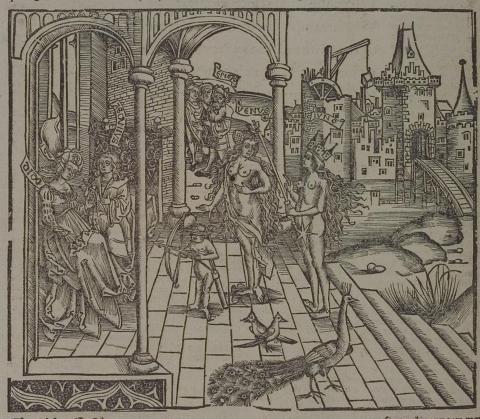Annotations
On the left, Dido sits with Ascanius either on her lap or right next to her, and she gestures to him in conversation (84-5). On the right, the city of Carthage stands with a tower half-built, and a crane stands idle (86-9). In the middle, Juno, wearing her citadel crown and holding a sceptre with a peacock at her feet, talks with Venus, who is shown with blind Cupid next to her and two doves at her feet. Unseen by the mortals, they concoct a plan to bring Aeneas and Dido together in an informal marriage (90-128). Aeneas and others stand in the background behind the two scheming goddesses. (Katy Purington)
Woodcut illustration from the “Strasbourg Vergil,” edited by Sebastian Brant: Publii Virgilii Maronis Opera cum quinque vulgatis commentariis expolitissimisque figuris atque imaginibus nuper per Sebastianum Brant superadditis (Strasbourg: Johannis Grieninger, 1502), fol. 212v, executed by an anonymous engraver under the direction of Brant.


Sebastian Brant (1458–1521) was a humanist scholar of many competencies. Trained in classics and law at the University of Basel, Brant later lectured in jurisprudence there and practiced law in his native city of Strasbourg. While his satirical poem Das Narrenschiff won him considerable standing as a writer, his role in the transmission of Virgil to the Renaissance was at least as important. In 1502 he and Strasbourg printer Johannes Grüninger produced a major edition of Virgil’s works, along with Donatus’ Life and the commentaries of Servius, Landino, and Calderini, with more than two hundred woodcut illustrations. (Annabel Patterson)